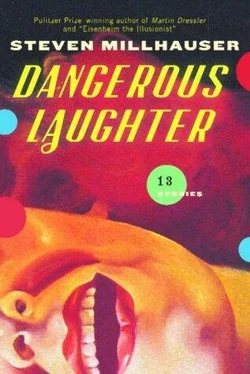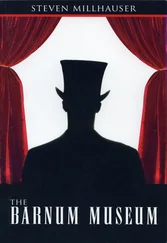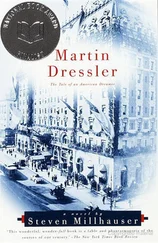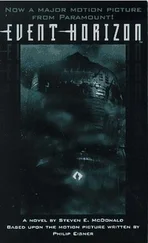It is therefore misleading and, if I may say so, wildly irresponsible for anyone to suggest that certain recent changes have somehow called into question our love for the past. The past is our passion and our life. It is our reason for existing. We’re proud, here at the Historical Society, to occupy the same building as the founders of our association. Located on historic Old Main Street, directly across from the town hall on the green, our white-shingled dwelling, shaded by two-hundred-year-old sycamores, was erected as a private residence in 1867 and purchased by the town six years later for the use of the new Historical Society. With its steep central gable and its ivy-covered chimney running the length of one wall, our home retains the essential shape of the original residence, while benefiting from two major alterations: the addition in 1899 of two rooms in the back, and the construction in 1945–46 of the handsome south wing, which now houses our research library and our extensive archives. Despite serious problems of space — we can scarcely accommodate our steadily growing collections — we resist all temptation to move to a larger and more up-to-date building, for from our front windows we can look out across Old Main Street at the eighteenth-century town hall and the war memorial commemorating the Revolutionary War dead. Both stand on the seventeenth-century green itself, where a granite boulder with a bronze plaque marks the year of our incorporation, 1648. In one of our second-floor exhibit rooms we have a musket dating from the Indian wars of 1646–47, which resulted in the ceding of a large tract of land (our present North End) by the Setaucus Indians, whose hand-carved flint arrowheads and quartz tools, some of them dating back to the fifteenth century, are on display in a Plexiglas case in a nearby room.
These exhibits are of the first importance, here at the Historical Society. The suggestion that we might use them to promote questionable ends is malicious and absurd. It’s precisely by means of our exhibits that we attract the vast majority of our visitors — the groups of elementary school children brought here by their teachers, the residents mildly curious about their town’s history, the outsiders with an idle hour or two who have exhausted the modest pleasures of Main Street, the young couples holding hands and stopping in for a look on their way to a beach party or a backyard barbecue. This is in no way to diminish the importance of our valuable research library, with its more than 4,000 volumes on the history of our town in every period, its 500 linear feet of archival material (deeds and legal documents), its manuscript holdings, and its wide-ranging collection of photographs, microfilms, maps, genealogical papers, cemetery records, immigration lists, and military pension registers. Nor do I in any sense mean to slight the numerous activities that are a vital part of our relation to the town: the walking tours, the children’s workshops, the preschool crafts program, the adult lecture series. But it remains true that it is principally through our exhibits that we connect most immediately with our visitors, who look to us for some sense, however confused and uncertain, of a common past. Even residents of Portuguese, Italian, and Slovakian descent, whose roots in our town rarely go back before the mid — nineteenth century, are often to be found peering at the illustrations on our eighteenth-century china dinner plates or looking curiously at our display of Puritan costumes. Our holdings include a number of popular permanent exhibits — the Setaucus arrowheads and stone tools, the Revolutionary War artifacts (including a cast-iron eight-pounder fieldpiece and three cannonballs), the seventeenth-century parlor — but we also present a broad array of well-attended temporary exhibits with shifting themes: Costume Fashions in the Victorian and Edwardian Doll, the Setaucus Village, Eighteenth-Century Farm Implements, the Puritan Schoolhouse, Main Street in 1895, the Coming of the Railroad.
Despite the variety and abundance of our exhibits, the artifacts on display represent only a fraction of those stored in our basement rooms, where we have a carefully cataloged and highly heterogeneous collection not open to the public. There, among some twenty thousand objects, you may find telegraph keys, riding crops, glass stereopticon slides, tin windup toys, cedar butter churns, Victorian dollhouses, tulip-globed brass cigar lighters, blunderbusses, Philco radios, Civil War uniforms, oaken well buckets, Edison phonographs with wax cylinders, spinning wheels, hoopskirts, and mahogany folding cameras with nickel trim. This large and always growing collection of artifacts, from which our displays are selected, is itself an incalculably minuscule fraction of objects haphazardly rescued from our past. At best they may be said to possess a representative value. The same is true of our other collections — the letters, diaries, photographs, and official documents of every variety that we accumulate in order to reveal a glimmer of all that’s gone. The knowledge that our evidence about the past is fragmentary and incomplete and, like all incomplete things, dangerously inaccurate spurs us to acquire still more evidence, while at the same time we realize with terrible clarity that we can never begin to approach the fullness and precision of the past — and this double knowledge, combined with a gradual change in our conception of history, has led to striking new developments, here at the Historical Society.
The immediate sign of a change is our series of new exhibits, mounted over the past two years. All have come under sharp attack. Perhaps our critics, who are so fertile with objections, might find it refreshing to pause for a few moments and consider whether their views may suffer from a narrow, facile, and insufficient grasp of the historical process. The new displays, mixed in with more conventional ones, include a large glass case filled with four shelves of carefully labeled pieces of litter (cellophane from a lollipop, a scrap of candy wrapper, bits of paper from Popsicles and toasted almond bars, pieces of potato chip bags and cigarette packs, torn straw wrappers); an eight-hour film showing nothing but the view from above of a backyard lawn containing grass, dandelions, chickweed, and clover, with the shadow of a garage moving gradually in from the left; and an audio booth in which one can listen to snatches of random conversation recorded in the aisles of our largest supermarket. Our critics accuse the displays of being uninstructive, uninteresting, and above all unhistorical. We believe the animus is directed against a change in the understanding of history itself.
History is the study of the past — but what is the past? It is everything that has happened up to the present. Precedence tends to be given to the distant past, which is separated from us less by time than by the absence of immediate sensual knowledge, so that the smallest fragment of a bowl from a seventeenth-century merchant’s family seems to contain within itself the revelation of a vanished world. But that same fragment, historically speaking, is of no more importance than yesterday’s teacup. The pastness of the past infects all artifacts equally. Cathedrals, stone ax-heads, cereal boxes, the Hanging Gardens of Babylon — all are leveled in the long democracy of the done. For just as, in a single moment of the distant past, an Egyptian comb is of no less historical interest than a pyramid, so in the vast stretch of all pastness a pyramid is of no more historical interest than a Coca-Cola bottle. Our task, as members of the Historical Society, is not to hierarchize the past, but to collect and preserve it.
This view of the past, which began to gain ground among us during the last years of the old millennium, has led to a new conception of the present. It’s our view, here at the Historical Society, that the present is the past made visible. Close your eyes and open them: in that instant of darkness, the entire world has fallen into the past. It is replaced by another world that itself is only a newer and more visible past. The science of optics informs us that the act of vision is a direct seeing of the past, since we see only after streams of photons, striking the photoreceptors in the retina, are transmuted into electrical impulses that travel along the optic nerve and make their way to the visual cortex. The present is our most recent past. It is also our most complete past. Indeed, we no longer use the word “present,” here at the Historical Society, but speak instead of the New Past.
Читать дальше












